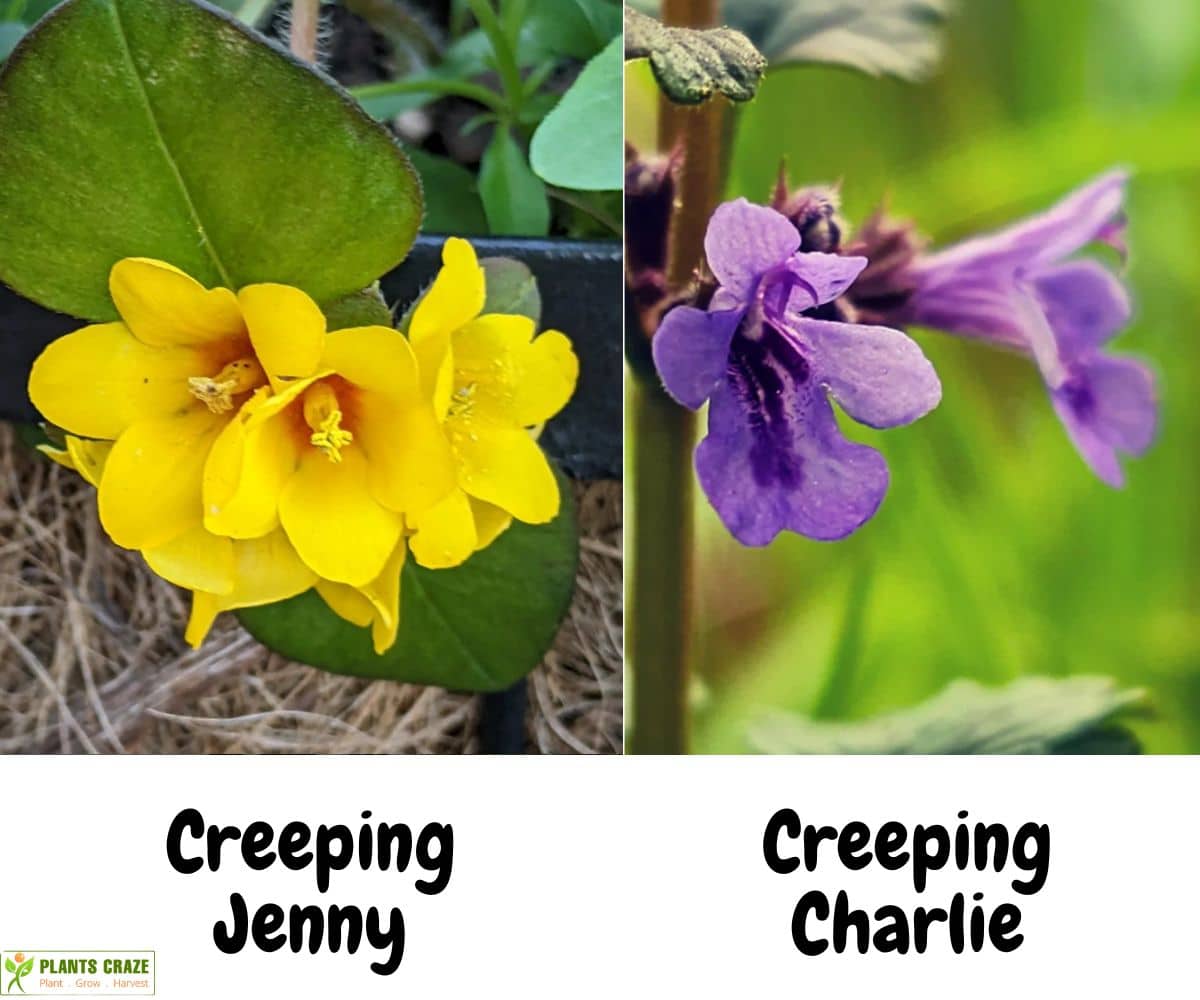The similar names of Creeping Jenny vs Creeping Charlie cause people to assume they are the same plant, but in reality, they are different.
Besides, the plants differ in shape, size, and toxicity nature.
Table of Contents Show
Are Creeping Jenny And Creeping Charlie The Same?
Most gardening beginners mistake Creeping Jenny for Creeping Charlie and vice versa for their exact similar resemblance.
But Creeping Jenny is not the same as Creeping Charlie.
While Creeping Jenny, aka Moneywort, belongs to the Primrose family, Creeping Charlie, aka English Ivy, is from the Mint family Lamiaceae.
The lateral stem of these plants spreads quickly and turns into invasive if not maintained.

Even with minimum soil moisture, Creeping Charlie and Jenny can take over your lawn and obstruct the growth of your houseplant.
Needless to worry, you can naturally control or kill both Creeping Charlie and Jenny by pruning the plants and blocking all the sunlight.
If the natural remedy fails to work, use broadleaf herbicides with dicamba or triclopyr that kills the Creeping Charlie and Jenny but not the entire lawn grass.
Creeping Jenny Vs Creeping Charlie: Key Differences
Besides the botanical classification, the visual difference between Moneywort and English Ivy might be difficult to decode without looking closer.
But correct identification is crucial to keep your garden and lawn safe from the invasion of the challenging one, i.e., Creeping Charlie.
1. Plant Size and Leaf Morphology
With the trailing growth habit, Creeping Jenny and Charlie spread its stem laterally, with one growing more in height than the other.
Further, the leaves of Jenny are round, glossy, and vibrant green, while Charlie has scalloped or kidney-shaped leaves with hairy textures.
2. Flower Pattern
Another visual difference between the creeping plants is the floral variation.
While both the flowers are small in size, Ground Ivy has funnel-shaped blooms with a flared upper lip and a narrow lower lip.
But the Moneywort flowers are star-shaped, with five petals radiating from the center.
3. Toxic Nature
Creeping Charlie is invasive and can threaten the surrounding plants, but it is entirely safe for your pets.
But, unlike the above, your pet may have minor stomach discomfort upon voracious consumption of Creeping Jenny. These are neither suitable for human consumption nor pets.
In case the symptoms do not subside for a long period, contact the nearest vet or the following helpline.
- Pet Poison Helpline: 855-764-7661
- Animal Poison Control Center: 888-426-4435
4. Blooming Time
Despite being perennial, Creeping Jenny blooms a little later than Creeping Charlie.
You’ll be able to notice the Jenny blooms from late spring or sometimes from early summer from zone 4-9. The blooms, however, do not last for a long time.
Similarly, Charlie is an early spring flower producer in zone 5 to zone 10. The flower lasts till the fall, starting from April or May.
Creeping Charlie Vs Other Look-alikes
Moneywort and English Ivy have some plants that bear superficial similarities and shared features.
So, let me help you by providing major distinguishing factors between Creeping Charlie vs Buttercups and Creeping Jenny vs Creeping Fig.
1. Creeping Charlie Vs Creeping Buttercups
Following the creeping growth patterns, Buttercups also joins the aggressively spreading clan.
Similar to the other Ranunculus plants, the Creeping Buttercup attains more height than the Creeping Charlie.
| Factors | Creeping Charlie | Creeping Buttercups |
|---|---|---|
| Scientific Name | Glechoma hederacea | Ranunculus repens |
| Common Name | Ground ivy | King County Weed |
| Plant Type | Herbaceous perennial | Low-growing Perennial |
| Family | Lamiaceae (Min) | Ranunculaceae |
| Plant Size | 4 to 12 inches tall About 1 meter wide spreading | 5 to 13 inches tall 2 to 3 feet spread |
| Leaf Structure | Green scalloped shaped leaves | Palmately divided leaves with three lobes from a central point |
| Flowering | Tubular flowers with purplish hue | Five petals cup-like flowers with a cluster of yellow stamen |
| USDA Zone | 5 to 10 | 9 and 10 |
2. Creeping Fig Vs Creeping Jenny
Unlike the mildly toxic Creeping Jenny, the Figs are woody vines that produce edible bell-shaped fruit.
These fruits are widely popular in Asian households and are used to prepare Grass Jelly.
| Factors | Creeping Jenny | Creeping Fig |
|---|---|---|
| Scientific Name | Lysimachia nummularia | Ficus pumila |
| Common Name | Moneywort | Creeping Fig |
| Plant Type | Herbaceous perennial | Woody perennial |
| Family | Primulaceae | Moraceae |
| Plant Size | 2 to 4 inches tall About 1 meter wide spreading | 20 to 30 feet tall 2 to 3 feet spread |
| Leaf Structure | Small, round and glossy leaves 1 inch in diameter | Small, oval-shaped leaves with leathery texture |
| Flowering | Yellow-cup shaped flowers | Small greenish yellow flower |
| Fruit | No Fruits | Pear-like hairy 3 inches long fruit |
| USDA Zone | 4 to 9 | 7 and 10 |
| Toxicity | Mildly toxic to pets | Non toxic |
From Editorial Team
Avoid Close Spacing!
Creeping Charlie and Creeping Jenny are both known for their potential to cover large areas.
So, provide enough space for each plant to spread and grow without excessive resource competition.


